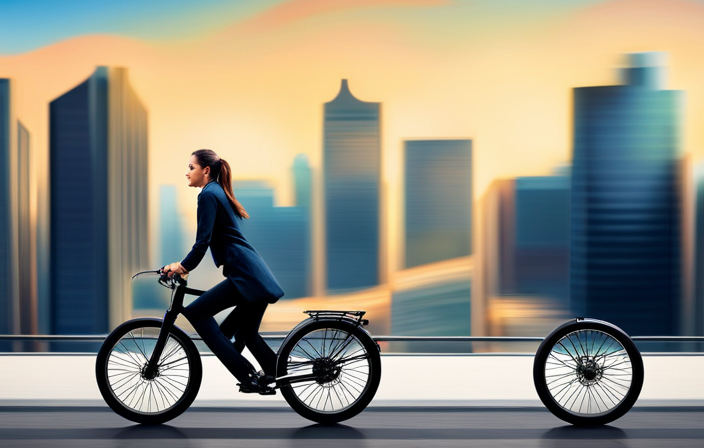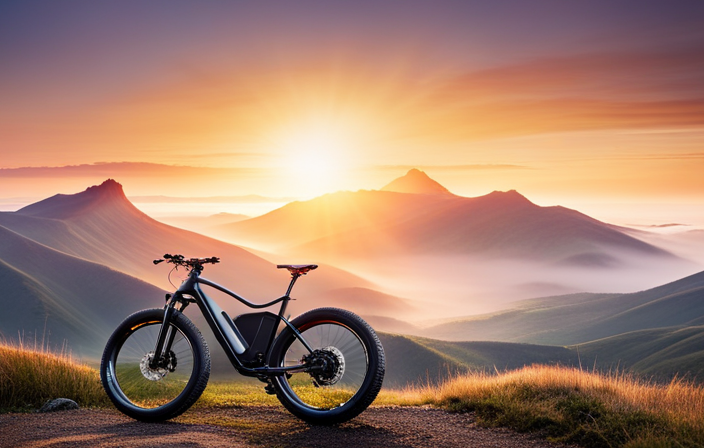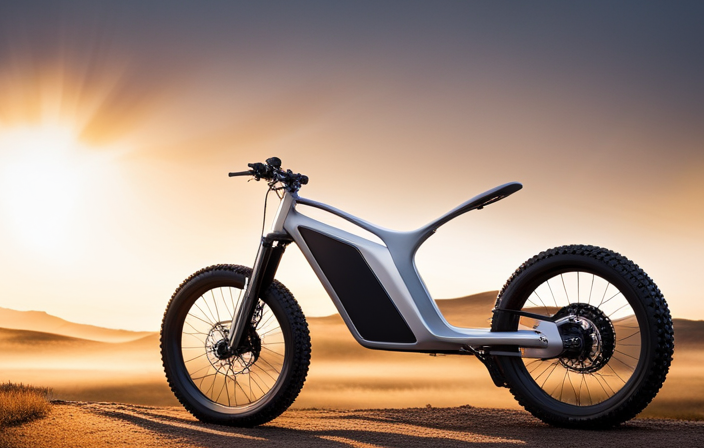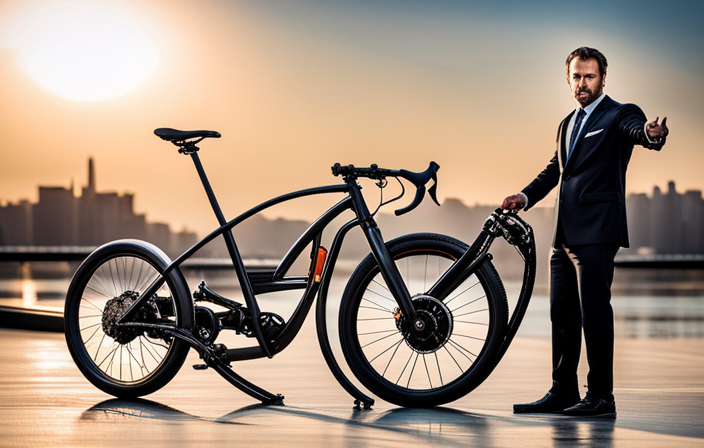Were you aware that the typical speed of an electric bike is approximately 20 miles per hour?
If you’re considering converting your bike into an electric one, understanding the different types of DC motors available is crucial.
From brushed to brushless, hub motors to geared motors, each option has its own advantages and limitations.
In this article, we will delve into the world of DC motors and guide you through the process of choosing the right motor for your electric bike conversion.
Key Takeaways
- Speed: Determine the desired maximum speed for the electric bike and choose a motor that aligns with the desired velocity.
- Power: Consider the motor’s wattage for better acceleration and climbing ability. Higher wattage motors provide more torque.
- Battery Compatibility: Ensure that the motor is compatible with the planned battery by checking voltage and current requirements. Match motor specifications with battery specifications.
- Consider specific application requirements: Take into account the speed and power requirements for specific applications to ensure optimal performance.
Understanding the Basics of DC Motors
DC motors are commonly used in electric bikes because of their efficiency and power. These motors operate on the principles of electromagnetic induction and are capable of converting electrical energy into mechanical energy.
The basic structure of a DC motor consists of a stator, which houses the stationary magnets, and a rotor, which contains the rotating armature. When an electric current is applied to the stator, it creates a magnetic field that interacts with the armature’s magnetic field, causing it to rotate.
DC motors offer several advantages for electric bikes, including high torque, compact size, and smooth acceleration. They are also relatively simple to control and maintain.
With this understanding of DC motors, let’s now explore the features and applications of brushed DC motors in electric bikes.
Brushed DC Motors: Features and Applications
Brushed motors, with their simple design and wide range of applications, offer a cost-effective solution for powering various devices. These motors have been used for decades and have proven to be reliable and efficient.
Here are some key features and applications of brushed DC motors:
-
Easy to control: Brushed motors can be easily controlled by adjusting the voltage or current supplied to them. This makes them suitable for a wide range of applications, from household appliances to industrial machinery.
-
High starting torque: Brushed motors provide high starting torque, making them ideal for applications that require quick acceleration, such as power tools and robotics.
-
Affordable maintenance: The maintenance of brushed motors is relatively simple and inexpensive. The brushes can be easily replaced, extending the motor’s lifespan.
-
Limited lifespan: However, one limitation of brushed motors is their limited lifespan due to the wear and tear of the brushes. This makes them less suitable for continuous operation or high-speed applications.
Now, let’s explore the advantages and limitations of brushless DC motors.
Brushless DC Motors: Advantages and Limitations
To fully understand the advantages and limitations of brushless DC motors, you’ll need to consider factors such as efficiency, durability, and maintenance requirements.
Brushless DC motors offer several advantages over their brushed counterparts. First and foremost, they are highly efficient, converting electrical energy into mechanical energy with minimal losses. This results in improved battery life and longer riding distances. Additionally, brushless motors are more durable due to the lack of brushes that wear out over time. They also require less maintenance since there are no brushes to replace or clean.
However, brushless DC motors tend to be more expensive and complex to control compared to brushed motors. Nevertheless, their improved efficiency and longer lifespan make them a popular choice among electric bike enthusiasts.
Now, let’s explore how hub motors power electric bikes.
Hub Motors: Powering Your Electric Bike
Hub motors, commonly used in electric bikes, offer a compact and efficient way to power your vehicle. These motors are directly integrated into the wheel hub, eliminating the need for additional transmission components. With a hub motor, you can experience a smooth and quiet ride, as the power is distributed evenly across the wheels.
To help you visualize the different types of hub motors available, here is a table comparing their key features:
| Type | Pros | Cons |
|---|---|---|
| Front Hub | Easy installation, balanced weight distribution | Limited traction, reduced maneuverability at turns |
| Rear Hub | Enhanced traction, better weight distribution | Increased complexity, added stress on the chain |
| All-wheel Hub | Improved traction, balanced weight distribution | Higher cost, increased power consumption |
Now, let’s delve into the next section on geared motors, which further enhance the efficiency and torque of your electric bike’s motor.
Geared Motors: Enhancing Efficiency and Torque
Geared motors, commonly found in electric vehicles, provide an efficient way to enhance the torque and overall efficiency of the motor. These motors consist of a combination of gears and a motor, allowing them to produce more torque at lower speeds. By using gears, the motor can operate at a higher speed while the vehicle moves at a slower speed, resulting in increased torque output. This makes geared motors ideal for applications where high torque is required, such as electric bikes.
The gears also help to optimize the motor’s efficiency by allowing it to run at its most efficient speed range. Geared motors are a popular choice for electric bike enthusiasts looking for a balance between power and efficiency.
Moving on to direct drive motors, these motors offer smooth and silent operation, making them another popular option for electric bikes.
Direct Drive Motors: Smooth and Silent Operation
Direct drive motors, also known as gearless motors, offer a smooth and silent operation compared to their geared counterparts. These motors have several advantages that make them ideal for electric bike conversions:
-
Increased efficiency: Direct drive motors eliminate the need for gears, resulting in less mechanical loss and improved efficiency.
-
Enhanced torque: These motors provide high torque output, allowing for better acceleration and hill climbing capabilities.
-
Low maintenance: With no gears to wear out or adjust, direct drive motors require minimal maintenance, saving you time and money.
Choosing the right motor for your electric bike conversion is crucial. It’s important to consider factors such as power requirements, weight, and compatibility with your bike’s frame. By selecting the appropriate motor, you can ensure optimal performance and a seamless conversion process.
Choosing the Right Motor for Your Electric Bike Conversion
When selecting a motor for your electric bike conversion, it’s important to consider factors such as power requirements, weight, and compatibility with your bike’s frame.
Power requirements determine the amount of torque and speed the motor can deliver. You need to ensure that the motor has enough power to propel your bike efficiently.
Additionally, the weight of the motor plays a crucial role in maintaining the overall balance of your bike. You don’t want a motor that is too heavy and affects the maneuverability of your bike.
Lastly, compatibility with your bike’s frame is essential to ensure easy installation and proper alignment of the motor.
Considering these factors will help you choose the right motor for your electric bike conversion, which we will discuss in the following sections regarding speed, power, and battery compatibility.
Factors to Consider: Speed, Power, and Battery Compatibility
To ensure optimal performance, you should consider the speed, power, and battery compatibility when selecting the right motor for your electric bike conversion.
-
Speed: Determine the maximum speed you want to achieve with your electric bike. Different motors have different maximum speeds, so choose one that aligns with your desired velocity.
-
Power: Consider the power output of the motor, which is measured in watts. Higher wattage motors provide more torque, enabling better acceleration and climbing ability.
-
Battery Compatibility: Ensure that the motor you choose is compatible with the battery you plan to use. Check the voltage and current requirements of the motor and ensure they match your battery specifications.
By carefully considering these factors, you can select a motor that meets your performance requirements.
With the right motor in place, you can now move on to the next step: installation and maintenance tips for dc motors.
Installation and Maintenance Tips for DC Motors
For optimal performance and longevity, make sure you follow these installation and maintenance tips for your DC motor. Proper installation and regular maintenance can greatly extend the lifespan of your motor and ensure its efficiency. Here are some key tips to keep in mind:
| Installation Tips | Maintenance Tips | Troubleshooting Tips |
|---|---|---|
| Mount the motor securely to prevent vibrations and damage | Regularly clean the motor to remove dirt and debris | Check for loose connections and tighten if necessary |
| Ensure proper alignment with the driven load | Lubricate the motor bearings as per manufacturer’s instructions | Monitor motor temperature and address overheating issues |
| Use the correct wiring and connectors for reliable connections | Inspect the motor brushes and replace if worn out | Check for unusual noise or vibrations and investigate the cause |
| Follow the manufacturer’s guidelines for voltage and current ratings | Regularly inspect and clean the motor commutator | Consult the manufacturer or a professional for complex issues |
Enhancing Performance: Controller and Motor Tuning
Enhancing the performance of your DC motor can be achieved through controller and motor tuning. By optimizing these components, you can maximize the efficiency and power output of your motor, leading to improved overall performance.
Here are four key factors to consider when tuning your DC motor and controller:
-
Current Limit: Adjusting the current limit allows you to control the motor’s power output. Increasing the current limit can provide more torque, while decreasing it can improve motor efficiency.
-
Speed Control: Fine-tuning the speed control settings enables you to achieve the desired acceleration and top speed for your application.
-
PID Parameters: Optimizing the proportional, integral, and derivative (PID) parameters can enhance motor response and stability.
-
Motor Timing: Adjusting the motor timing can result in smoother operation and reduced power losses.
Conclusion
To conclude, when it comes to choosing a DC motor for your electric bike, it’s crucial to consider factors such as speed, power, and battery compatibility.
Whether you opt for a brushed or brushless motor, or even a hub or geared motor, each has its own advantages and limitations.
Remember to also focus on proper installation and maintenance to ensure optimal performance.
So, take the time to research and select the right motor for your electric bike conversion, and get ready to enjoy an efficient and powerful ride.
Now you have all the tools to embark on your electric bike adventure!









